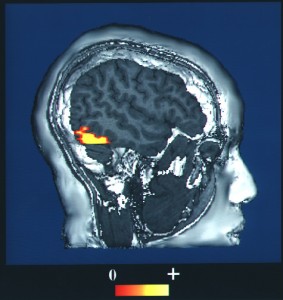
Neurofeedback is not new. It has been around since the 1960’s and used by some practitioners as a form of biofeedback measuring brain waves. Proponents have been using it in the area of ADHD and more recently in treating bedwetting, but it has really suffered from a deficit of good scientific studies to ascertain its actual value.
A new study has recently looked at how neurofeedback could be used to train a specific area of brain activity: in this case to improve brain function of the visual cortex.
Here the subjects were asked to imagine images and to try and increase the amount of activity they could see in their own brains while observing their own brain’s activity on real time brain imaging (fMRI). There is something probably quite amazing about being able to see your own brain patterns of activity light up in this type of exercise.
Following this training the subjects then had their visual perception tested. This required them to detect very subtle changes in the contrast of an image. Those who had learnt the neurofeedback technique were shown to have a higher ability to detect even very small changes in contrast (but only when they were actively exerting control over their brain activity).
This study is unique because of the use of real time imaging compared to previous studies that have used recordings of electrical brain activity.
The beauty of this is that it is possible to see exactly where the training is having an effect. So in the future it may become easier to target training for a specific function for example where a person has sustained a brain injury such as stroke.
There has been an astronomical amount of growth in the development of online brain training software over the last few years and considerable accompanying debate as to whether such brain training can really afford much real long lasting positive change in brain function. However the amount of supportive evidence is slowly increasing and this study is a nice example. It appears likely there will be an increasing amount of self brain training available, whether for treatment and management of brain disorders and injury, or for maintenance or improvement of existing brain function.
The lead researcher for this study, Dr. Frank Scharnowski, appears optimistic about using this technique as a way to train people to help their own brain and improve their visual sensitivity without the need for surgery or drugs. He states the next step is to use this clinically to determine whether it offers people (such as those who have suffered a stroke) any benefit to their perception skills, even if there is no damage to their vision.
A grand vision indeed.
Ref: Scharnowski F et al. Improving visual perception through neurofeedback. J Neurosci 2012 [epub].

